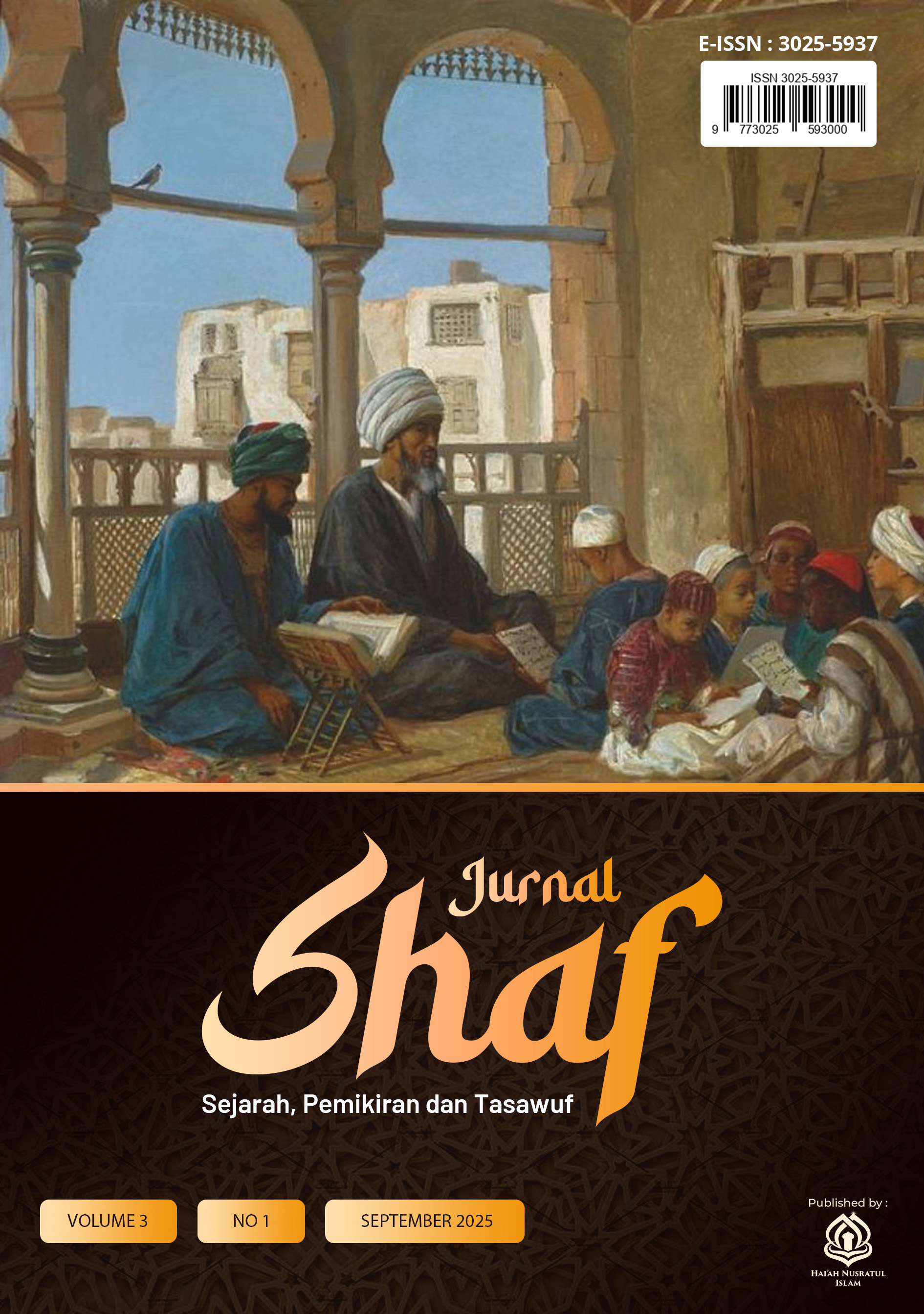FUNGSI KALIGRAFI ARAB SEBAGAI MEDIA DAKWAH VISUAL DI MASYARAKAT MUSLIM MODERN
DOI:
https://doi.org/10.59548/js.v3i1.451Keywords:
Arabic Calligraphy, Visual Dakwah, Islamic Art, Modern Muslim SocietyAbstract
Arabic calligraphy is one form of Islamic art that not only contains high aesthetic value, but is also full of spiritual messages. In the context of modern Muslim society, Arabic calligraphy is not only found in places of worship, but also in digital media, popular culture products, and public spaces. This study aims to examine the function of research using a descriptive qualitative approach through library studies and observations of visual da'wah media that utilize calligraphy. The results of the study show that Arabic calligraphy functions as a means of reminding Islamic values, strengthening the visual identity of Islam, and a bridge of communication for da'wah that is authentic in the digital era.
References
Al-Jabiri, M. (2020). Arabic Calligraphy as Universal Cultural Heritage. International Journal of Cultural Studies, 10(2), 35–46.
Al-Khateeb, A. (2016). The Spiritual and Artistic Dimensions of Islamic Calligraphy. Journal of Islamic Cultural Studies, 8(2), 45–60.
Amin, S. (2022). Modern Trends in Islamic Calligraphy for Da’wah Purposes. Islamic Arts and Culture Journal, 19(1), 20–34.
Blair, S. S. (2006). Islamic Calligraphy. Edinburgh: Edinburgh University Press.
Blair, S., & Bloom, J. (199manfaat). The Art and Architecture of Islam 1250–1800. Yale University Press.
Collins, S. P., Storrow, A., Liu, D., Jenkins, C. A., Miller, K. F., Kampe, C., & Butler, J. (2021).
Deroche, F. (2014). The Abbasid Tradition: Qur’ans of the 8th to 10th centuries AD. The Nasser D. Khalili Collection of Islamic Art, Vol. I.
Fahmi, S. (2021). Visual Aesthetics and Da’wah: The Impact of Calligraphy on Audience Reception. Journal of Islamic Media Studies, 9(2), 33–50.
Farid, N. (2021). Preserving Artistic Tradition in Modern Islamic Education: The Role of Calligraphy. Journal of Islamic Education and Culture, 8(3), 62–73.
Fazira, E., & S, F. (2023). Seni Kaligrafi Dalam Pandangan Islam. Jurnal Ekshis, 1(2), 70–80. https://doi.org/10.59548/je.v1i2.79
Frishman, M., & Khan, H. (Eds.). (1994). The Mosque; History, Architectural Development & Regional Diversity. Thames and Hudson.
Hamid, R., & Kamaruddin, N. (2019). Public Display of Islamic Calligraphy and Its Role in Promoting Social Harmony. Journal of Islamic Public Spaces, 5(1), 15–27.
Hasan, M., & Qureshi, A. (2015). Artistic and Spiritual Intersection of Arabic Calligraphy. Journal of Middle Eastern Studies, 11(3), 56–70.
Hasani, C., Yani, E. F., & Putra, M. D. B. (2025). Estetika Kaligrafi Islam Dan Implikasinya Dengan Ilmu Tasawuf. Shaf: Jurnal Sejarah, Pemikiran dan Tasawuf, 2(2), 114–125. https://doi.org/10.59548/js.v2i2.346
Ibrahim, M., Zain, N., & Abdullah, S. (2017). Islamic Calligraphy as Media Dakwah: A Contemporary Perspective. International Journal of Islamic Studies, 12(3), 77–89.
Mahmood, R. (2018). Calligraphy as a Medium of Islamic Visual Culture. Art & Religion Journal, 10(1), 22–38.
Nasr, S. H. (1987). Islamic Art and Spirituality. State University of New York Press.
Nasution, H., Ikhsan, M., & Aziz, D. (2020). Islamic Calligraphy as Social Identity: A Sociocultural Perspective. Journal of Islamic Sociology, 12(1), 88–99.
Nurhadi, A. (2016). The Transformation of Arabic Calligraphy in the Digital Era. Journal of Islamic Design, 7(2), 9–21.
Rahman, T. (2019). Cultural Identity and Islamic Art: The Case of Arabic Calligraphy. Journal of Cultural Heritage and Identity, 6(1), 15–27.
Rispul, R. (2012). Kaligrafi Arab sebagai Karya Seni. TSAQAFA, Jurnal Kajian Seni Budaya, 1(1), 9–18. https://eprints.uad.ac.id/1486/3/02-tsaqafa-Rispul-kaligrafi-arab-sebagai-seni.pdf
Saeed, L. (2019). The Spiritual Linguistics of Arabic Calligraphy. Journal of Qur’anic Studies, 15(1), 101–116.
Safadi, Y. H. (1978). Islamic Calligraphy. Thames and Hudson.
Sakkal, M. (2009). Modern Arabic Calligraphy. Leonardo Journal, 42(3).
Schimmel, A. (1984). Calligraphy and Islamic Culture. New York University Press.
Suhardi, F. (2017). Teaching the Quranic Values through Calligraphy in Islamic Education. Islamic Pedagogy Journal, 3(2), 41–54.
Sulaiman, K. (2022). The Digital Revolution and the Future of Traditional Islamic Arts. Journal of Contemporary Islamic Art, 15(2), 77–90.
Ummu Bissalam. (2024). Transformasi Kaligrafi Tradisional Ke Digital Sebagai Media Dakwah Era Baru. Al-Mutsla, 6(2), 502–521. https://doi.org/10.46870/jstain.v6i2.1236
UNESCO. (2018). The protection and promotion of calligraphic art as intangible cultural heritage. UNESCO Report.
Widiatmika, K. P. (2015). Etika Jurnalisme Pada Koran Kuning: Sebuah Studi Mengenai Koran Lampu Hijau, 16(2), 39–55.
Yazid, H. (2020). The Role of Arabic Calligraphy in Religious Communication. Religion and Art Review, 14(4), 85–95.
Yusuf, M., & Rahman, A. (2023). Innovation in Islamic Visual Art: Digital Calligraphy as a Medium for Islamic Values. Contemporary Islamic Art Journal, 21(4), 105–120.
Zainuddin, Y. (2018). Digital Media and Islamic Calligraphy: A Bridge between Tradition and Modernity. Journal of Digital Islamic Studies, 4(5), 44–59.
Downloads
Published
How to Cite
Issue
Section
Categories
License
Copyright (c) 2025 Qothrunnadha Qothrunnadha, Muhammad Arif Billah, Ulil Albab, Muhammad Fikri Al-Mujaki, Dzulfaqor Daffa, Muhammad Mukti Adli, Sultan Yazid, Minatur Rokhim

This work is licensed under a Creative Commons Attribution 4.0 International License.
- Share — copy and redistribute the material in any medium or format for any purpose, even commercially.
- Adapt — remix, transform, and build upon the material for any purpose, even commercially.
- The licensor cannot revoke these freedoms as long as you follow the license terms.
Under the following terms:
- Attribution — You must give appropriate credit , provide a link to the license, and indicate if changes were made . You may do so in any reasonable manner, but not in any way that suggests the licensor endorses you or your use.
- No additional restrictions — You may not apply legal terms or technological measures that legally restrict others from doing anything the license permits.
Notices:
You do not have to comply with the license for elements of the material in the public domain or where your use is permitted by an applicable exception or limitation .
No warranties are given. The license may not give you all of the permissions necessary for your intended use. For example, other rights such as publicity, privacy, or moral rights may limit how you use the material.













